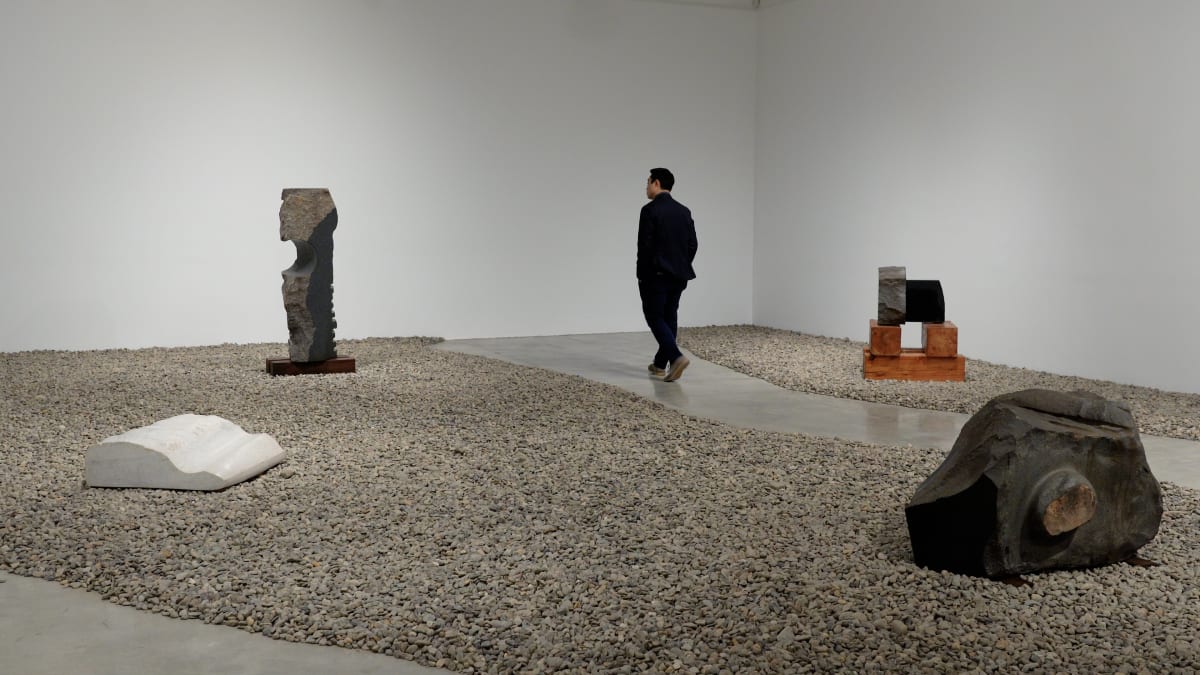Minoru Niizuma: Waterfall in Autumn Wind
Tina Kim Gallery is pleased to announce its first exhibition dedicated to the practice of Japanese-American sculptor and educator Minoru Niizuma (b. 1930, Tokyo; d. 1998, New York). Recognized for his abstract marble sculptures in the postwar period, Niizuma exhibited widely in the United States and Europe, and was an active organizer of public sculpture exhibitions across both continents. Although a lifelong artist and educator whose works entered multiple institutional and private collections, Niizuma’s legacy has rarely been acknowledged since his passing at the age of 67, in part due to a lack of formal representation. Marking the first attempt to introduce a deeper understanding of the artist’s practice, the exhibition brings together works from two key decades of his practice—the 1970s and 80s. In addition, on view are a range of rare archival material that contextualizes his efforts to promote broader cross-cultural understandings between the US, Europe, and Japan through his stone-carving symposiums, exhibitions, and public sculpture parks. Accompanying this exhibition will also be an illustrated exhibition catalog, featuring an extended introduction of the artist written by art historian and curator Reiko Tomii.
Born in Tokyo in 1930 and educated at the Tokyo National University of Fine Arts and Music, Niizuma immigrated to New York in 1959 and joined the Brooklyn Museum Art School as an instructor in 1964. Upon establishing his studio practice in New York, Niizuma attained the space needed to develop larger-scale sculptures; soon after, his work was included in both the 1966 and 1968 Whitney Annuals, as well as a landmark survey of Japanese Art that traveled through five institutions across the US, including the San Francisco Museum of Modern Art and the Museum of Modern Art, New York. Throughout his life, Niizuma worked in series, focusing on refining and iterating a single form over the course of several years.
Although affiliated with the emerging artistic cluster that came to become known as “Minimalism,” Niizuma’s artistic development remained intrinsically indebted to the properties of his oft-chosen mediums: marble and granite. Beginning from the 1970s and 80s onwards, Niizuma increasingly chose to execute his works in ways that revealed—rather than obviated—the natural appearance of stone, reacting against the prevailing emphasis on industrial material and processes dominating sculptural practice during that time. In contrast with his earlier work from the 1960s, which are often characterized by highly polished surfaces and geometric forms, the works included in the exhibition bear evidence of the artist’s intention to restrain his own hand. As exemplified by works such as Windy Wind (c.1970s), the surfaces of the sculptures are marked by grooves, crags, and furrows. Yet, the rough-hewn appearance of Niizuma’s works is contrasted with the organic, fluid forms that the artist employed. Harboring a love of mountain climbing, many of the forms of Niizuma’s sculptures are inspired by his own encounters with natural environments, which he alludes to in the title of each respective work.
Apart from key works, the exhibition also includes select archival material that contextualizes Niizuma’s efforts to promote artistic exchange during these key decades. Niizuma established significant relationships with artists and art professionals, including Isamu Noguchi, George Segal, and Yoko Ono, amongst others. In addition, he played an integral role in organizing exhibitions that introduced Japanese sculptors to New York in various venues, including the Sculpture Center. Earlier in 1971, Niizuma had also organized a symposium of stone sculpture in New York City, commissioning new works from artists and displaying them in outdoor, public sites across the city. Over the course of the next two decades, Niizuma would go on to organize and participate in multiple “stone symposiums” across various locations including Vermont, Portugal, Ireland, and Austria. Often, he and other participants would draw on the local marble and granite quarries to create new works that were then exhibited to the public. In the 1980s, Niizuma began traveling to Portugal extensively because of the immense array of marble and stone available, eventually resulting in a partnership with Portuguese President Mario Soares to build artistic exchange between Portugal and Japan. Today, many of Niizuma’s large-scale public sculptures can still be seen throughout the United States, Europe, and Japan. They reflect his own artistic development but also stand as a testament to his passion for promoting stone carving across these continents.
Special thanks to Arata Niizuma and the Estate of Minoru Niizuma for their collaboration on this exhibition.
ABOUT TINA KIM GALLERY
Founded in New York in 2001 by Tina Kim and located in Chelsea, Tina Kim Gallery is celebrated for its unique programming that emphasizes international contemporary artists, historical overviews, and independently curated shows. With the gallery’s strong focus on Asian contemporary artists, Tina Kim has become a leading figure in introducing the Korean Dansaekhwa art movement to the American audience. Furthermore, she has created a platform for emerging and renowned artists such as Lee Seung Jio, Pacita Abad, Kim Tschang-Yeul, Tania Pérez Córdova, Minouk Lim, Davide Balliano, and Suki Seokyeong Kang. Through its programming, the gallery works closely with internationally renowned curators for special exhibitions and produces scholarly art publications.
SALE INQUIRES
inquiries@tinakimgallery.com
+1 (212) 716-1100
PRESS INQUIRES
Jillian Scott | Third Eye
jillian@hellothirdeye.com
+1 (212) 355-9009 x 313


